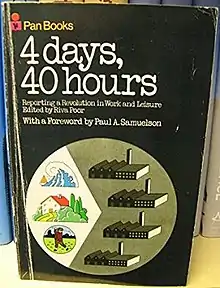4 Days, 40 Hours
4 Days, 40 Hours is a 1971 book by Riva Poor reporting on a "revolution in work and leisure" from a rearranged work week with four days of 10 hours each.[1] In some cases, the book claims, companies can increase production and profit while giving employees more time off.[2][3]
 | |
| Author | Riva Poor |
|---|---|
| Language | English |
| Publisher | Bursk and Poor Publishing |
Publication date | July 17, 1971 |
| ISBN | 978-0451612328 |
The book was inspired by an article in the Boston Globe about the successful introduction of the four-day week in a Kyanize Paints factory in Everett, Massachusetts.[4]
Reception
In 1971, the book received attention in a New York Times article that tied it to a growing trend in companies to allow a four-day workweek.[5] Heartened by the response, Poor said, "I predict that within the next five years just about every business in the country will be giving it serious consideration."[4] In another article about the four-day workweek in 1976, The New York Times called 4 Days, 40 Hours "the definitive reference work in this field."[6]
A 1975 review of the book's second edition in The Journal of Human Resources said that Poor "can only be described as radiantly positive about [the 4-day workweek's] potential for good, and utterly unconvinced by the negative criticism from trade union and other sources... She is definitely not impressed by the argument that 10-hour days are fatiguing, or that they represent a regression to 19th century standards." While she does not give much attention to alternatives, "this focus does permit her to concentrate on presenting us with a spirited defense of a four-day, 40-hour schedule, and, as such, her book is to be recommended."[7]
The book's publication led to an increase in her management consulting work; according to a 1979 UPI profile, "The book quickly became a hot item in American industry, and her star was launched."[8]
However, the concept did not actually catch on, and in 1989, an article in the Boston Globe called it "a management fad that went the way of zero-based budgeting and the Boston Consulting Group's cow-and-doggy grid."[9]
David Hamilton wrote, "Her research indicates that the shorter week is most successful in small, nondiversified industries."[10]
A review by Leon E. Lunden in Monthly Labor Review reads, ""repetitive and spotty as it is in part, the book nevertheless reflects the enthusiasm of the various authors for 4-40 and their conviction that it will spread rapidly".[11]
References
- Rotenberg, Ronald T.; Martin, Dennis (Autumn 1977). "The Rearranged Work Week: What Effect on Marketing?". Business Quarterly. 42 (3): 58. ProQuest 224804738.
- "The 4-Day Work Week Is Coming ...", Illinois Parks and Recreation, 9 July/August, 1971.
- Poor, Riva (1973-01-01). 4 days, 40 hours and other forms of the rearranged workweek. New American Library.
- Botwright, Ken (July 11, 1971). "The 4-Day Work Week Is Spreading". Parade. Retrieved 23 July 2020.
- Salpukas, Ages (March 20, 1971). "4‐Day, 40‐Hour Work Week Gains in Small Companies". The New York Times. p. 23. Retrieved 23 July 2020.
- Sloane, Leonard (August 20, 1976). "Management". The New York Times. Retrieved 23 July 2020.
- Owen, John D. (Spring 1975). "Review: 4 Days, 40 Hours". The Journal of Human Resources. 10 (2): 264–265. doi:10.2307/144831. JSTOR 144831.
- "Riva Poor wants to be a business star". United Press International. June 23, 1979. Retrieved 23 July 2020.
- Beam, Alex (February 1, 1989). "Who the Heck is Riva Poor?". Boston Globe. ProQuest 294457134.
- Alicia Patterson Foundation website
- Lunden, Leon E. (1971). "The long weekend". Monthly Labor Review. 94 (7): 74–75. JSTOR 41838345.